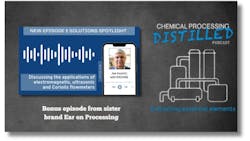Podcast: The Lowdown on Electromagnetic, Ultrasonic and Coriolis Flowmeters
Transcript
Jesse Osborne:
Welcome to this Solution Spotlight episode of Ear on Processing, sponsored by KROHNE. I'm Processing's chief editor, Jesse Osborne, and I'm joined today by Joe Incontri, who is the Director of Marketing for North America at KROHNE. Joe, it's great to talk with you again.
Joe Incontri:
Well, thank you. Right back at you, Jesse.
Jesse:
So today's conversation is going to cover all things flow meters, and to kick things off, can you provide a quick overview of KROHNE's history in the flow meter marketplace?
Joe:
Well, some people might claim I've been around since the beginning of KROHNE, but that's not true since we started back in the early 1920s. So the company's well over a hundred years old at this point. Our first meter that we brought into production back then was the variable area flow meter. In the fifties, we brought out some electromagnetic flow meters, and then ultrasonic meters and mass meters and other technologies that kind of fulfilled the need. Inductive shouldn't be overlooked as well in the sixties and seventies. We also introduced some level instruments—mechanical level at first, and then onto radar technologies. So we were an early pioneer in all of the technologies.
Jesse:
So the last time we talked to you, we covered radar level measurements in the process industries. To quickly revisit that topic, could you touch on KROHNE's recent radar level line expansion and how these solutions can help process manufacturers?
Joe:
Sure. So we touched on the Optiwave 1500 series, which is basically a low-cost radar for level or open channel type applications, and we've seen an expansion of that particular product line. Now, just recently actually—we've been waiting for the FCC approval and we just got it literally this week—so now we have two more products that are introduced to the family: the 1530 and the Optiwave 1560. Both are hermetically sealed devices with three-inch antennas, as opposed to the one-and-a-half-inch antennas that are available on the 1520 and 1540 products that we spoke about last time. These new versions basically provide higher performance in terms of accuracy and also longer range. So the 1530 can now be used on granulates and solids to 50 feet, while the 1560 can be used for liquids to about a hundred feet. And they both have concave lenses as opposed to convex lenses, which limit the impact of dust or condensation on the radar signal.
Jesse:
Okay, Joe, turning our attention to flow meters, the company's Tidalflux electromagnetic flow meter has been around for years and it's still as popular as ever. Why is that?
Joe:
Well, the Tidalflux is really unique, and that pretty well is the short answer. But fundamentally, it offers more accuracy and less maintenance needs than other technologies. So this translates into more information for process optimization and even for regulatory reporting. When it comes to process plants like wastewater or water treatment facilities, open channel flow can often be impractical in situations where plants want to limit the amount of gases that are released into the atmosphere. So having a closed pipe solution really addresses what the government imposes in the Clean Water Act, which expects facilities to limit any emissions. And that's where the Tidalflux is a unique combination to do so, because it is a closed pipe instrument. It can be applied to sludge, influent, or combined sewer lines, even in fully submerged service. And talk about sustainability—we still have several meters, several Tidalflux meters and Optiflux for that matter, that have been installed for over 25 years and are still operating reliably in their facilities just as they were from the outset.
Now, as compared to open channel or even area velocity meters, which need to be set up and validated on site, the Tidalflux is still the only device on the marketplace that comes with a factory traceable calibration certificate. And then, oh yeah, it's a mag meter. So that means you can do all sorts of field-based tests to verify that the electrodes or any other element of the electromagnetic circuit is still operating within its original specifications. So we do have some onsite testing that you can hook up to the instrument to validate that and provide a certificate to that effect.
Jesse:
You just mentioned mag meters. Is there any news surrounding KROHNE's other mag meters?
Joe:
I'm not going to give up all those secrets, but yes, we do have some things that we've just developed in terms of communications options, and we're going to have those on display at WEFTEC. So if you're in the area, please stop by. We'd love to talk to you about what we can do now with communications.
Jesse:
Okay. And then switching gears to clamp-on ultrasonic products, what makes KROHNE's products unique in that segment?
Joe:
Well, so KROHNE has the Optisonic product line, the Optisonic 6000 series, and it comes in either a fixed or a portable clamp-on type device. And it has a unique sensor mount rail. This rigid rail system makes it a whole lot easier to align the sensors since they're both mounted on the same metal rail. And for a clamp-on ultrasonic meter to work, you basically have a sending system—a signal and a receiving. So we have transducers that have to basically be aligned to pick up the signals reliably. And having a single rail system makes it a whole lot easier to install these because they're automatically aligned, and you don't have to worry about the signal strength at that point, especially on small to mid-size pipes up to 24 inches in diameter. Since both sensors are lined up on one rail, if you have larger pipes, then we would have two rails and you would have to adjust them, but it makes it a lot easier with the rails as opposed to individual sensors that would be mounted separately.
Now, for temporary installations, we also offer magnetic pipe mounts, which is great for metal pipes because that greatly simplifies the sensor installation as compared to individually mounting sensors using straps. We shouldn't also overlook the signal processing—the receiving device—which allows our devices to be used on some of the more challenging pipes, including FRP lines, those plastic pipes, fiberglass pipes that have proven to be a challenge for other technologies. Well, our instrument can be adapted to it quite easily. If you have a flow issue in your plant, the portable clamp-on meter is also a great way to use it to validate any other technology you might be using for measuring that flow.
Jesse:
And then to follow up on that, when should someone consider using an inline ultrasonic meter in their operations?
Joe:
So as compared to portable devices like we just talked about—the portable clamp-on instrument, which can almost uniquely be applied just to clean or relatively clean fluids or normal fluids—inline meters offer a number of opportunities to expand that range of application. We have solutions for gas, for example, and even biogas measurement. That's an inline device. You can also bring in secondary values like temperature or pressure so that you can expand the information coming out of the devices, like corrected flow, for example. Now, take it to the nth degree—this really wouldn't necessarily apply to the water or wastewater industries—but ultrasonic meters, inline ultrasonic meters, are used for custody transfer applications on pipelines, for example, like in the oil and gas transmission pipeline industry, or for chemicals and so forth. For liquids in the process, ultrasonic meters offer the reliability of mag meters, but they can apply to non-conductive fluids. So if you have gas or liquid flows, these devices offer higher accuracy and repeatability than differential pressure or even turbine or positive displacement meters or clamp-on instruments for that matter.
Jesse:
Coriolis mass meters have been coming on strong for some industrial applications. How do KROHNE meters stand out in that segment of the industry?
Joe:
Sorry for the pun, but I'll get to the point straight away. That pretty well sums up our key difference. We have cost-effective straight tube solutions, which are awesome for dense fluids that might clog up bent tube meters, or corrosive and erosive fluids that might otherwise erode the bend points on a bent tube meter. And the good news is that these straight tube meters don't cost a whole lot more, if anything more, than what you might otherwise consider in a bent tube device. They also make great replacements for positive displacement metering pumps, which have a lot of moving parts as compared to Coriolis meters. Now, to be clear, we have a full range of Coriolis mass meter designs and different materials, so we'd love the opportunity to help you with any optimal mass measurement solution you might be considering. And yeah, if it can be done with mass meters, KROHNE has a solution for it.
Jesse:
And Joe, how can listeners find out more about KROHNE's flow meter product lineup?
Joe:
Well, like anything else in this day and age, visit our webpage. We also have a full page dedicated to the water and wastewater industry where you'll find all sorts of applications. To get there, start with our general page, which is us.krohne.com, and then look for the Industries tab at the top of the page and look for Water and Wastewater Industry, and you'll dive right into all of the solutions we have available for this important marketplace.
Jesse:
And Joe, before we wrap things up today, are there any overarching industry themes that KROHNE is currently aligning with?
Joe:
Well, you might've heard of something called sustainability, and it seems to be on everybody's tongues these days. Well, we've had instruments installed and operating continually since the seventies or eighties in facilities throughout North America, and I'm talking about mag meters here. So if you're looking for something sustainable that's going to be around for a long time, we have some solutions we'd love to talk to you about. The other topic that is a big deal and kind of ties into this as well is maintainability and traceability. We have onsite traceable verification devices that all but eliminate the need for taking flow meters out of service. That's a big deal. Taking a meter out of service involves a lot of logistical exercises—shipping it somewhere and then shipping it back and reinstalling it—can be pretty expensive. Having something where you can validate the performance against a known standard is pretty compelling. We'd love to talk to you about that as well while we're at the booth.
Jesse:
That concludes this Solution Spotlight episode of Ear on Processing, sponsored by KROHNE.
About the Author
Traci Purdum
Editor-in-Chief
Traci Purdum, an award-winning business journalist with extensive experience covering manufacturing and management issues, is a graduate of the Kent State University School of Journalism and Mass Communication, Kent, Ohio, and an alumnus of the Wharton Seminar for Business Journalists, Wharton School of Business, University of Pennsylvania, Philadelphia.

